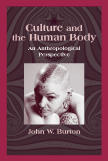“Burton offers an anthropological perspective on culture and the human body that deftly presents the broad scholarly concerns that in recent years have proliferated enormously. From a comparative perspective, he presents a cross-cultural survey of particular bodily images, activities, and associations found around the world in both the past and present and in both small-scale face-to-face and large-scale technologically advanced societies to illustrate the importance of cultural differences, while illustrating the commonality of the human condition for which the human body is central. Beginning with the universals of an embodied evolutionary history, Burton ferries the reader through anthropological perspectives on the social lives on bodies in which normative social forms and practices interface self and society, culture and biology, and inscribe the body as a communicative system productive in the context of social relations. Continuing with anthropological examples of the centricity of the body in identity formations across history and cultures by focusing on ethnicity and gender, he closes with a discussion of the increasing dependency of the ‘modern body’ on complex forms of technology. For undergraduate and general readership, Burton skillfully handles this panoramic literature while introducing an equally wide range of theoretical orientations on culture and the human body that is illuminating and appealing indeed.” — Choice
“A concise overview of the interplay between the human form and cultural constructions of that form. This work, using the cultural construction of the body, can be used in a variety of courses.” —Gregory R. Campbell, University of Montana
“This short volume touches upon many of the most important questions in anthropology relating to the human body. I was actually surprised to see how much Burton could pack into this small space.” —Misty L. Bastian, Franklin and Marshall College
“The book was both enlightening and informative. The premise that physical adornment is often a social construction of cultural values is important for all disciplines, especially the field of medical anthropology. Chapter 5 on Technology and the Body was fascinating. Overall, I enjoyed this book and would consider including it in many of the classes I teach.” —Rose De Luca, Bay State College

129 pages, $22.95 list
1-57766-180-X
978-1-57766-180-1
© 2001
paperback
Culture and the Human Body
An Anthropological Perspective
In the course of human prehistory and continuing to the present day, culture has played a prominent role in transforming the human form. From birth to death, the body serves as a medium and metaphor of cultural expression. This book provides a broadly comparative perspective on the many and varied ways in which the human body has been sculpted and transformed by particular cultural traditions and argues that in significant ways, the human body has transcended the laws of natural selection. To appreciate the human body is to acknowledge the various ways in which it has become a cultural artifact rather than a purely natural phenomenon.
Reactions
Introduction. An Anthropology of the Human Body
1. Human Evolution and Human Culture
2. You and Me: The Social Life of the Body
3. Us and Them: Ethnicity, Identity, and the Body
4. Him and Her: Initiation and the Body
5. Now and Then: Technology and the Body
1. Human Evolution and Human Culture
2. You and Me: The Social Life of the Body
3. Us and Them: Ethnicity, Identity, and the Body
4. Him and Her: Initiation and the Body
5. Now and Then: Technology and the Body